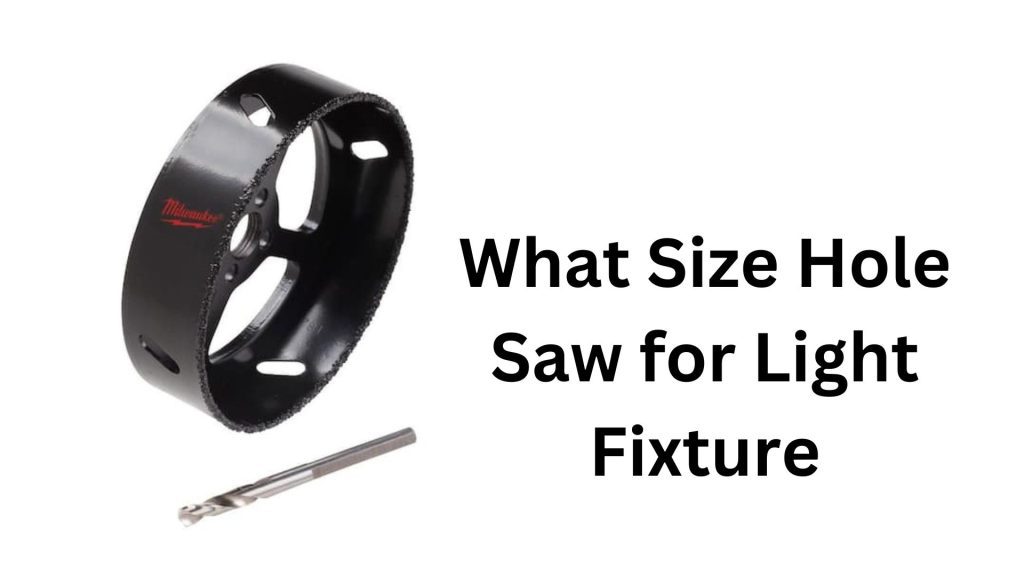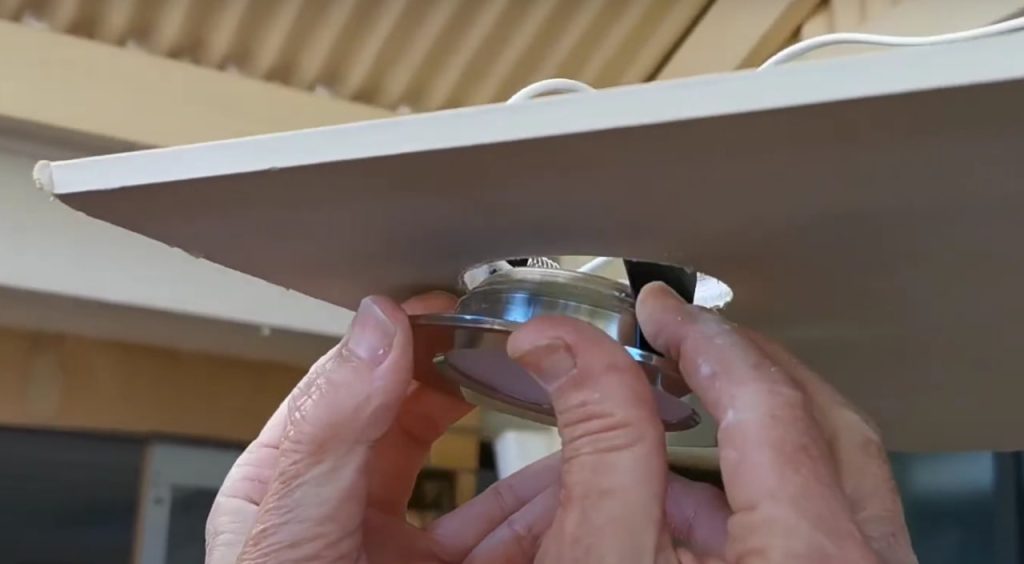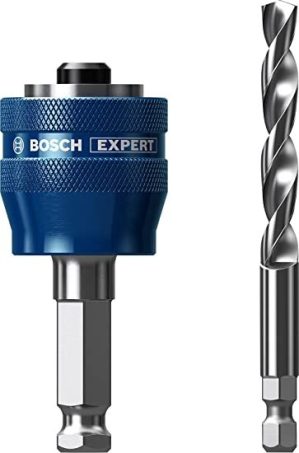What Size Hole Saw for Light Fixture? There are different sizes of hole saws available in the market and it can be confusing to choose the right one for your needs. If you’re wondering what size hole saw you need for a light fixture, then this article is for you. We’ll go over some expert guidelines that will help you make the best decision for your project.

When it comes to choosing the right size hole saw for your light fixture, there are a few things to keep in mind. First, you’ll need to know the diameter of the hole you need to cut. Second, you’ll want to consider the depth of the cut.
And third, you’ll need to take into account the type of material you’re cutting through. With that said, let’s take a closer look at each of these factors so you can make the best decision for your project. The diameter of the hole is probably the most important factor to consider when choosing a hole saw.
If you get a saw that’s too small, it won’t be able to cut through the material. On the other hand, if you get one that’s too large, it will be more difficult to control and could cause damage to the surrounding area. So, what’s the best way to determine the right size?
The easiest way is to measure the existing hole and then add 1/8″ to 1/4″. This will give you enough room to work with and should result in a nice clean cut. Depth is another important consideration when selecting a hole saw.
Hole Saw Depth
If you only need to make a shallow cut, then a standard length bit will probably suffice. However, if you’re cutting through thicker material or need to make a deeper cut, then you’ll want to opt for a longer bit. Just keep in mind that longer bits are more difficult to control and can cause more damage if not used properly.
Finally, take into account what type of material you’ll be cutting through when choosing a hole saw. If it’s something soft like wood or plastic, then just about any size will do. However, if you’re working with metal or tile, then you’ll want to use a smaller diameter bit so as not to put too much stress on the blade.
In conclusion, there are several things to bear in mind when selecting a hole saw for your light fixture project. Keep these guidelines in mind and you should have no problem finding the perfect tool for the job!
Hole Saw Trick (Making Holes Larger)
What Size Hole Saws Do I Need?
Assuming you are referring to hole saws for woodworking, the size of the hole saw you need will depend on the thickness of the material you are drilling through. For example, if you are drilling through a 1-inch thick piece of wood, you will need a 1-inch hole saw. Hole saws come in a variety of sizes, so it is important to select the right size for your project.
A larger hole saw will be able to make a bigger hole, but it will also require more power to operate and may not be necessary for your project. To determine what size hole saw you need, first measure the thickness of the material you will be drilling through. Once you know that measurement, select a hole saw that is slightly larger than that measurement.
For example, if you are measuring the thickness of a piece of wood and it is 1 inch thick, choose a 1-1/4 inch hole saw. This will give you enough clearance to drill through the material without damaging it. When selecting a hole saw, always err on the side of choosing a larger size rather than a smaller one.
It is much easier to enlarge a small hole than it is to try and make a large one smaller.
What Size Hole Saw Electrical?
What size hole saw electrical? This is a difficult question to answer without more information. The size of the hole saw will depend on the application.
For example, if you are drilling through metal, you will need a different size than if you are drilling through wood.

How Do I Choose a Hole Saw?
There are a few things to consider when choosing a hole saw. The first is the size of the hole you need to make. Hole saws come in a variety of sizes, so it’s important to choose one that will fit your needs.
The second thing to consider is the material you’ll be cutting through. Some materials, like wood, are easier to cut through than others, like metal. Choose a hole saw that is designed for the material you’ll be working with.
Finally, consider the depth of the cut you need to make. Some hole saws can only make shallow cuts, while others can make deeper ones. Choose the right tool for the job at hand.
What are the Most Popular Hole Saw Sizes?
There are many different applications for hole saws, so the most popular sizes vary depending on the intended use. For example, the most popular size for cutting holes in softwood boards is 7/8 inches, while 1-1/4 inches is more popular for cutting holes in metal. The depth of the teeth also affects the popularity of a particular size; deeper teeth are better suited for tougher materials like concrete, while shallower teeth are better for softer materials like wood.
What Size Hole Saw for Light Box
When it comes to choosing the right size hole saw for your lightbox, there are a few things to keep in mind. The first is the size of the box itself. The second is the thickness of the material you’ll be cutting through.
And lastly, you’ll want to consider the type of light fixture you’re using. Let’s start with the size of the box. If you have a small light box, then you won’t need a large hole saw.
Conversely, if you have a large light box, then you’ll need a larger hole saw. It’s important to get the right size so that your hole is just big enough for your light fixture. Next, let’s talk about material thickness.
If you’re cutting through thin material, then you can use a smaller hole saw. But if you’re cutting through thick material, then you’ll need a larger hole saw. This is because thicker material requires more force to cut through and a smaller hole saw just won’t be able to do it effectively.
Finally, let’s talk about the type of light fixture being used. If you’re using a standard incandescent bulb, then any size hole saw will work fine since they don’t produce much heat. However, if you’re using an LED or other type of high-powered light bulb, then you’ll want to get a bigger hole saw so that there’s more ventilation around the bulb.
What Size Hole Saw for Round Electrical Box
If you’re installing an electrical box, you’ll need to drill a hole in the wall for it. But what size hole saw should you use? The answer depends on the size of the electrical box.
For a standard round electrical box, you’ll need a 2-1/8″ hole saw. If the box is larger, you may need a bigger hole saw. Remember, when drilling into walls, always wear safety goggles and use a dust mask to avoid breathing in any debris.
What Size Hole for Ceiling Fan Box
Ceiling fans are a great way to keep your home cool during the summer months. But before you can enjoy the benefits of a ceiling fan, you need to install it properly. That means having the right size hole for your ceiling fan box.
The size of the hole you need will depend on the model of ceiling fan you have. Most ceiling fans come with a template that you can use to mark the correct size hole on your ceiling. If your fan doesn’t come with a template, you can measure the width and height of the base of the fan and add two inches to each measurement.
This will give you plenty of room to work with when installing your new ceiling fan. Once you’ve cut the hole in your ceiling, it’s time to install the box that will support your new ceiling fan. The type of box you need will also be determined by the model of ceiling fan you have.
Most boxes are either octagonal or square-shaped and come with all the necessary hardware for installation. Once your box is in place, simply follow the instructions that came with your ceiling fan to complete the installation process. In no time at all, you’ll be enjoying cool breezes courtesy of your new Ceiling Fan!
Starrett Hole Saw Sizes Pdf
If you’re looking for information on Starrett hole saw sizes, you’ve come to the right place. In this blog post, we’ll provide detailed information on the different sizes of Starrett hole saws so that you can make an informed decision when purchasing one for your next project. Starrett hole saws are available in a variety of sizes, from small to large.
The most common size is the 7/8″ diameter, but other popular sizes include 1″, 1-1/4″, and 1-1/2″. There are also larger sizes available, such as 2″ and 3″, but these are less common. When choosing a size, it’s important to consider the material you’ll be cutting through.
For example, if you’re cutting through metal, you’ll need a larger size than if you’re just cutting through wood. Additionally, it’s important to think about the thickness of the material you’re cutting. Thicker material will require a larger hole saw than a thinner one.
Once you’ve considered all of these factors, it’s time to choose a size. If you’re still not sure which size to choose, don’t hesitate to ask an associate at your local hardware store for help. They should be able to point you in the right direction based on your specific needs.
What Size Hole for Electrical Box
An electrical box is a metal or plastic box used to house electrical connections. The size of the hole for an electrical box depends on the type of electrical box and the application. There are many different types of electrical boxes, including junction boxes, outlet boxes, switch boxes, and fixture boxes.
The most common type of electrical box is the junction box. Junction boxes are used to make splices in wires or to connect wires to devices such as switches or outlets. The size of the hole for a junction box must be large enough to accommodate all of the wires that will be entering or exiting the box.
Junction Box
The National Electrical Code (NEC) requires that junction boxes have a minimum internal volume of 2 cubic inches (in3). The NEC also requires that junction boxes have at least 3/8 inch (9.5 mm) knockouts on each side, end, and bottom so that they can be easily mounted flush with a wall surface. The size of the hole for an outlet box must be large enough to accommodate all of the wires that will be entering or exiting the box as well as any devices that will be installed in the outlet box such as switches or outlets.
Outlet boxes must have a minimum internal volume of 2 cubic inches (in3). Switch boxes must also have a minimum internal volume of 2 cubic inches (in3). In addition, switch boxes must have at least two 3/8 inch (9.5 mm) knockouts on each side so that they can be easily mounted flush with a wall surface.
Fixture Box
Fixture Boxes are similar to outlet boxes but are designed specifically for mounting light fixtures. FixtureBoxes come in two basic types: old work and new work fixture boxes. An old work fixture box is intended for installation in an existing structure where it will be attached to framing members that are already present.
A new work fixture box is intended for installation in a freshly constructed structure or during a major remodeling project where it will be built into them, a son by or sheetrock walls during construction. Fixtureboxeshaveaminimuminternalvolumeof2cubicinches(in3), and they are to be knocked out with one or more1 / 2 -inch(12 . 7 -mm)diameter knockout located on the side and back of the box.
Standard Light Fixture Hole Size
If you’re planning on hanging a new light fixture, it’s important to know the standard light fixture hole size. This will ensure that your new light fixture will fit properly and look great in your space. The standard light fixture hole size is 8 inches.
This is the most common size for light fixtures, so it’s a good bet that your new light will fit into this hole size. However, it’s always a good idea to measure the hole in your space before purchasing a new light fixture just to be sure. When hanging a new light, it’s also important to consider the weight of the fixture.
Make sure that the chosen spot can support the weight of your new light before making any decisions. With a little planning and consideration, you can hang a beautiful and functional new light in your home with ease!

Hole Saw Drill Bit for Metal
A hole saw is a type of saw used to cut holes in thin materials. It consists of a metal cylinder with teeth on the outside edge and a pilot bit in the center. The pilot bit is used to start the hole and the teeth are used to cut through the material.
Hole saws are typically used for cutting holes in wood, metal, or plastic. They can be used with hand-held drills, drill presses, or machining centers. Hole saws vary in size from small (1/4 inch) to large (12 inches).
The most common sizes are 1/2 inch, 3/4 inch, and 1 inch. When choosing a hole saw, it is important to select one that is sized appropriately for the material being drilled and the thickness of that material. For example, a 1/2 inch hole saw should not be used on metal thicker than 1/8 inch.
Likewise, a 12-inch hole saw should not be used on wood thinner than 3 inches thick. Hole saws can be purchased at most hardware stores or online retailers.
Hole Saw Bit 6 Inch
A hole saw, also known as a hole saw or a circular saw is a tool used to cut circular holes in wood, metal, or other materials. It consists of a metal body with teeth on the periphery and an attached pilot drill bit in the center. The pilot drill bit is used to start the hole and guide the hole saw through the material.
Hole saws are available in a variety of sizes and can be used with hand-held drills, drill presses, or lathes. Hole saws are typically used to cut holes for pipes, dowels, screws, or bolts. They can also be used to enlarge existing holes.
When cutting through thicker materials, such as metal plates or concrete blocks, it may be necessary to use multiple hole saws in sequence to complete the job.
Conclusion
Hole saws are an important tool for any electrician or homeowner who wants to install a new light fixture. But what size hole saw should you use for your project? This expert guide will help you choose the right size hole saw for your light fixture, based on the type of material you’re using and the thickness of the finished product.
With this information in hand, you’ll be able to complete your project quickly and easily, without any frustrating delays.
FAQ
What size hole saw I need for a 4-can light?
The ideal hole saw size for a 4-inch can light is 4-⅜. You can also take the can light’s diameter measurement to ensure you are getting the right product from the store
What size hole saw do I need for a lightbox?
For light boxes, recessed lights, or electrical outlets, you can get the right size by measuring the back of the lightbox or outlet. This will give u the exact size measurement for the hole saw you would need to buy

I’m John Carry, also known as a woodworker I have been a professional saw expert for over 10 years. I’d work with every type of saw machine out there, and experiment to find which tools work better.
I’m always looking for ways to improve my skills and help those around me. I love my job and am always happy to share my knowledge with others.


